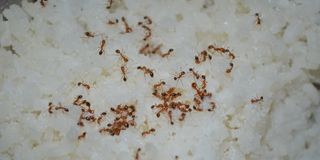Prime
Getting rid of ants from your home

Ants can be a nuisance in a home. PHOTOs/unspalsh.com.
What you need to know:
Ants usually move in search of food, water or nesting space. The first step to dealing with ants in your house therefore, is ensuring they do not have access to any of these
Have you had those situations where an ant invasion feels like a plague? From destroying plants to finding their way to your food and sometimes your bed, ants can be such a nuisance.
Ants are colonial creatures and always move in colonies, usually move in search of food, water or nesting space.
The first step to dealing with ants in your house therefore, is ensuring they do not have access to any of these.
“To prevent ants from invading your home, for instance seal all food in airtight containers, clean behind the fridge and in the toaster, do not leave pet food out longer than necessary and ensure your bins are tightly sealed,” says Alvin Muhumuza, the operations manager at Advanced Cleaning Services.
In Uganda, there are two categories of ants; sugar ants (those drawn to sugary substance) and the protein ants (those drawn to protein-laden foods) but control methods are similar.
Fumigation: This is predominantly what most Ugandans want to use and the fumigants on the market can be got from Container Village in Kampala However, this may not be effective in some instances yet it is labour intensive and costly in regards to the quantity of fumigant used.
Muhumuza says the most effective way is dealing with the colony which necessitates one to find where the ants carry the foods.
“That enables you to deal with the ants, their larvae as well as the queen. In so doing, you not only get rid of the active ants but also their eggs which would replace them in a matter of days. Additionally, killing the queen means that production is cut off,” he says.
Poisonous substance
This method means looking for what they feed on. For instance a homeowner will poison the protein or the sugar the ants carry back to the colony.
“The method works well in instances where you cannot find their habitation because the ants will carry the poison back to the colony thereby killing off the entire colony,” he says.
Muhumuza says the chemicals used to kill tropical ants or insects are available on the market.
Natural methods
Ground red or black pepper
Also known as cayenne pepper, red pepper as well as black pepper creates an uncomfortable environment for the ants due to the irritating smell. When using this method, sprinkle some pepper in paths the ants commonly use as well as behind cupboards and appliances.
“While young children may pick a few grains of pepper, more so along the ant paths, the effects are not as disastrous as if one got an allergic attack,” Winnie Nassaka, a homeowner shares.
Tea tree oil
Its smell is a repellent for ants. When using it, Nassaka recommends putting a few drops (five to 10) of the oil into two cups of water in a spray bottle. Shake the mixture well and spray in those places where ants are commonly seen.
“You can also spray the mixture in cotton balls and put them around the home. However, this may not be sustainable in instances where ants appear often or where the house is big,” she says.
Peppermint
This is a good insect repellent that deters several insects. When working with peppermint, add 10 to 20 drops of the oil into two cups of water in a spray bottle.
“Shake the mixture well then spray where you usually see the insects such as along the house walls, around windows and behind cupboards,” Nassaka says.
Exterior ants
However, some of these ants are found outside, such as termites. To fight these requires different methods.
“There are chemicals you can pour into the anthill to kill them, even the larvae and the queen. However, anthills sometimes span over a sizeable piece of land so you need to scan the land to see if there are any others, more so when you are new in the place. Even when you have been around for a while, looking out for anthills being formed is worth the search,” he says.
Once these have been mapped out, the necessary amount of chemical is purchased and one 20 litre jerry can is poured in each anthill before the entire colony dies.
“Carefully follow the instructions on the label of the chemical in regards to dilution, use as well as storage,” he says.





